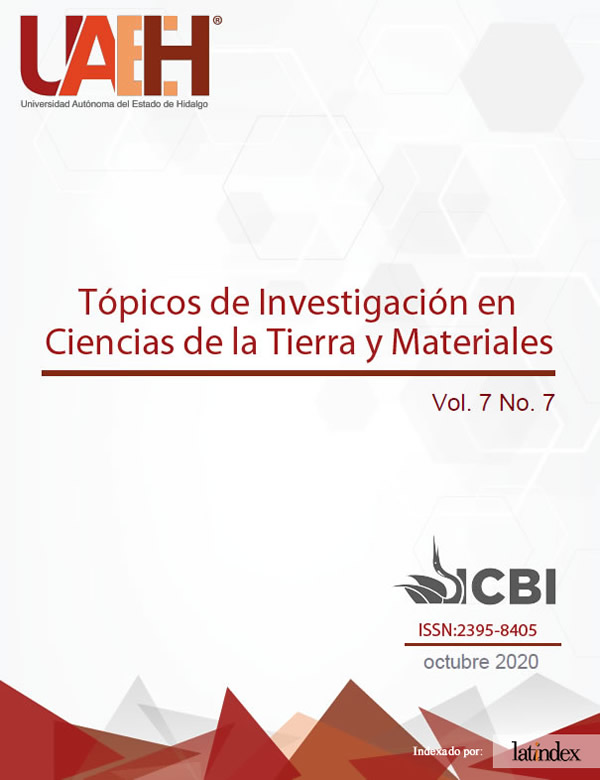Empleo de electrodos de pasta de carbono (CPE) para evaluar las interacciones entre un mineral de galena y los reactivos típicos del proceso de flotación
DOI:
https://doi.org/10.29057/aactm.v7i7.6190Palabras clave:
Flotacion, minerales de sulfuro, galena, adsorción de xantato, oxidación electroquímicaResumen
Se presenta un análisis para evaluar las interacciones del mineral de galena (PbS) y los reactivos típicos del proceso de flotación, usando electrodos de pasta de carbono (CPE) y técnicas electroquímicas. Se realizaron estudios comparativos de voltametría y variación del potencial de reposo para evaluar las interacciones entre la galena y n-isopropil xantato de sodio (NaIPX), con y sin acondicionamiento previo. Las pruebas con la solución en blanco (sin xantato) y electrodo en blanco (CPE-sin mineral) se utilizaron para analizar la adsorción del xantato y los mecanismos de reacción entre las especies, a diferente pH. El análisis determinó que la adsorción de xantato ocurre a potenciales entre -0.25 y 0.05 V, mientras que la flotación se ve favorecida en potenciales entre –0.05 a 0.05 V, debido a la cercanía entre el potencial de reposo y el potencial de formación de Pb(X)2, S0 o X2. El acondicionamiento previo de la superficie mineral de galena con depresores, limita la cinética del proceso de adsorción de xantato y la formación de especies hidrófobas.
Descargas
Información de Publicación
Perfiles de revisores N/D
Declaraciones del autor
Indexado en
- Sociedad académica
- N/D
Citas
Fuerstenau DW. Advances in Flotation Technology, Society for Mining Metallurgy & Exploration, Englewood, Colorado, 1999; p. 3.
Buckley AN, Hope GA, and Woods R. Solid-Liquid Interfaces, Ed. by K. Wandelt and S. Thurgate, Topics Appl. Phys. 2003; 85: 61-66.
Fuerstenau M C, Jameson G J, Yoon RH. Froth flotation: a century of innovation. SME, Littleton, Colorado, 2007; p. 6.
Bolin N J, and Laskowski J S. Polysaccharides in flotation of sulphides. Part II. Copper/lead separation with dextrin and sodium hydroxide, International Journal of Mineral Processing. 1991; 33(1-4): 235-241.
Chander S, Khan A. Effect of sulfur dioxide on flotation of chalcopyrite, International Journal of Mineral Processing 2000; 58(1-4): 45-55.
Qi L, Yahui Z. Effect of calcium ions and citric acid on the flotation separation of chalcopyrite from galena using dextrin, Minerals Engineering 2000; 13(13): 1405-1416.
Raju G, Holmgren A, Forsling W. Adsorption of dextrin at mineral/wáter interface, Journal of Colloid and Interface Science, 1997; 193(2): 215-222.
Rath RK, Subramanian S. Adsorption, electrokinetic and differential flotation studies on sphalerite and galena using dextrin. International Journal of Mineral Processing 1999; 57(4): 265-283
Drzymala J, Kapusniak J, Tomasik P. Removal of lead minerals from copper industrial flotation concentrates by xanthate flotation in the presence of dextrin, International Journal of Mineral Processing 2003; 70(1-4): 147-155.
Grano SR, Prestidge CA, Ralston J. Sulphite modification of galena surfaces and its effect on flotation and xanthate adsorption. International Journal of Mineral Processing, 1997; 52(1): 1-29.
Urbano G, Lázaro I, Rodríguez I, Reyes JL, Larios R, Cruz R. Electrochemical and spectroscopic study of interfacial interactions between chalcopyrite and typical flotation process reagents. International Journal of Minerals, Metallurgy, and Materials, 2016; 23(2): 127-136.
Richadson P. E, O’Dell C S. Semiconducting Characteristics of Galena Electrodes Relationship to Mineral Flotation, J. Electrochem. Soc. 1985; 132(6): 1350.
Woods R. Modern Aspects of Electrochemistry; [In] J. O. Bockris, B. E. Conway, R. E. White, Eds., Plenum Press: New York, 1996, No. 29, p. 401.
Woods R. In Principles of Mineral Flotation. The Wark Symposium; Jones, M. H., Woodcock, J. T., Eds.; Ausralasian Institute of Mining and Metallurgy (AIMM): Parkville, Victoria, Australia, 1984; 91-116.
Dutra AJ, Espínola A, Sampaio J. A, Electrochemical depression of galena aiming at selective sulfide flotation. Journal of the Brazilian Chemical Society, 1997; 8(2): 193-196.
Chernyshova I. Anodic processes on a galena (PbS) electrode in the presence of n-butyl xanthate studied FTIR-Spectroelectrochemically, J. Phys. Chem. B, 2001; 105(34): 8185-8191.
Woods R. In Flotation; Fuerstenau, M. C., Ed.; American Institute of Mining and Petroleum Enginneer, Inc.: New York, 1976; A. M. Gaudin Memorial Volume, Vol. 1, p. 298-333.
Moreno-Medrano ED, Casillas N, Cruz R, Lara-Castro R. Study of adsorption of sodium isopropyl xanthate on galena, Mes Electrochemistry As A Tool for Sustainable Development, 2011; 36(1): 463.
Toperi D, Tolun R. Electrochemical study and thermodynamic equilibria of the galena-oxygen-xanthate flotation system. Trans. Inst. Min. Metall. C, 1969; 78: 191-197.
Gardner JR, Woods R. Electrochemical investigation of contact angle and of flotation in the presence of alkylxanthates. II. Galena and pyrite surfaces. Australian Journal of Chemistry, 1977; 30(5): 981-991.
Leppinen JO, Basilio CI, Yoon RH. In-situ FTIR study of ethyl xanthate adsorption on sulfide minerals under conditions of controlled potential. International Journal of Mineral Processing, 1989; 26(3-4): 259-274.
Chernyshova I. In situ FTIR-spectroelectrochemical study of the anodic processes on a galena (PbS) electrode under open-air conditions in the absence and presence of n-butyl xanthate. Langmuir, 2002 18(18): 6962-6968.
Urbano G, Meléndez AM, Reyes VE, Veloz MA, González I. Galvanic interactions between galena–sphalerite and their reactivity. International Journal of Mineral Processing, 2007; 82(3): 148-155.
Buckley AN, Woods R. Identifying chemisorption in the interaction of thiol collectors with sulfide minerals by XPS: adsorption of xanthate on silver and silver sulfide. Colloids and Surfaces A: Physicochemical and Engineering Aspects, 1995; 104(2-3): 295-305.
Lekki J, Chmielewski T. Mechanizm sorpcji ksantogenianu na powierzchni galeny w zakresie stężeń stosowanych w praktyce flotacyjnej, Fizykochem. Probl. Mineralurgii, 1989; 21: 127-140.
Fuerstenau MC, Miller JD, Kuhn MC. Chemistry of Flotation,. Society of Mining Engineers of the American Institute of Mining, Metallurgical and Petroleum Engineers. Inc, New York. 1985.


















